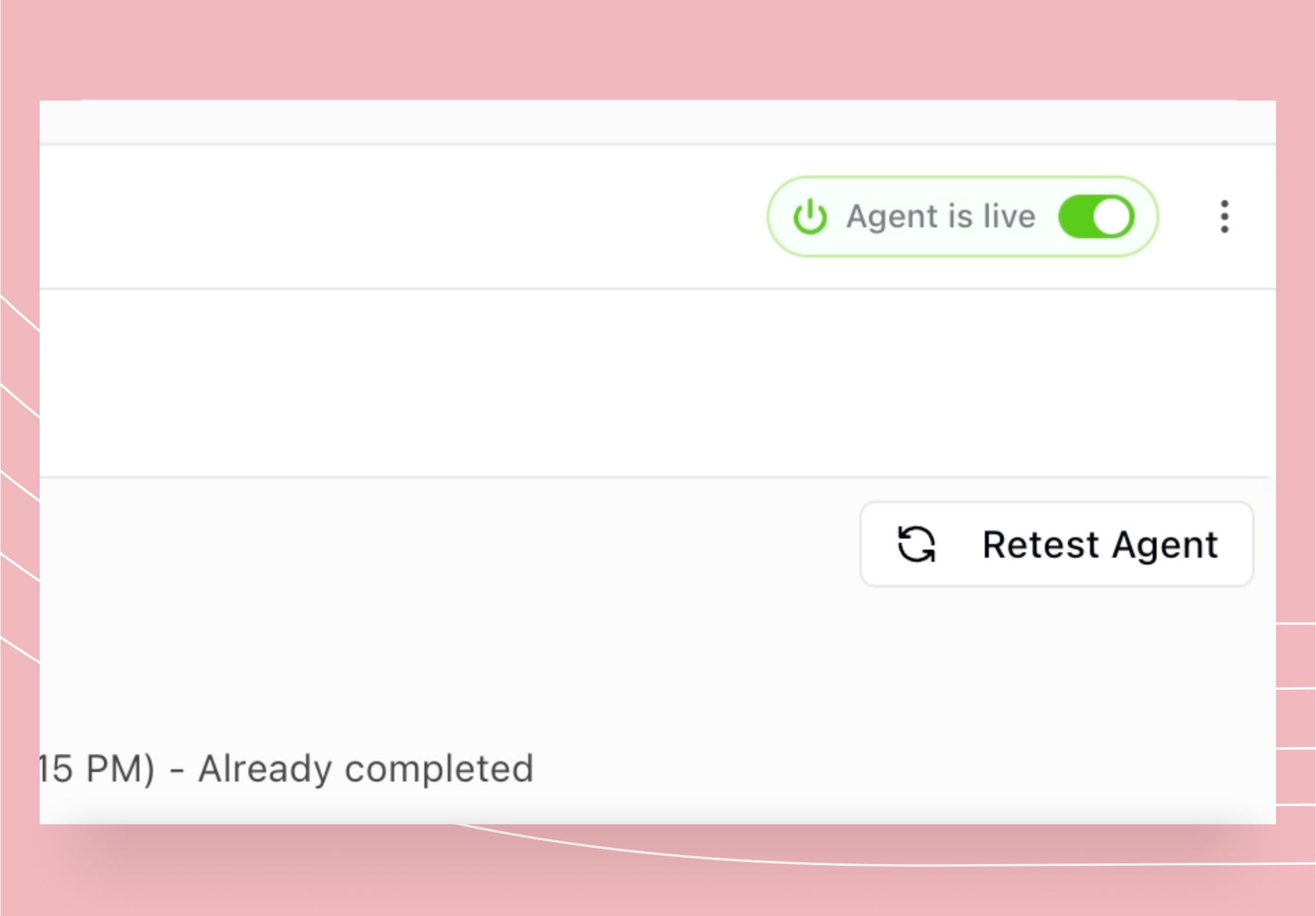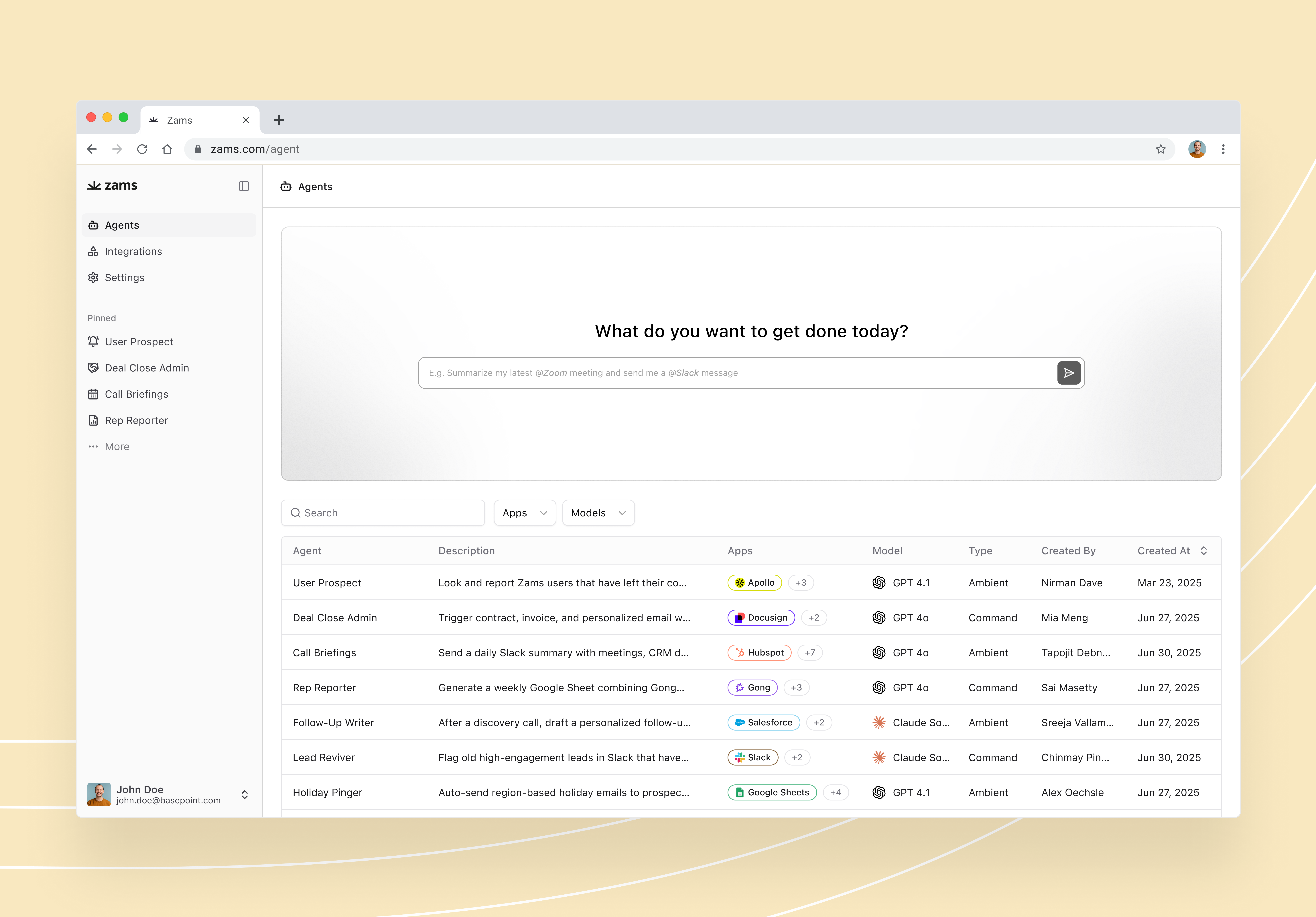AI agents aren’t just tools anymore, they’re teammates. They parse RFQs, resolve customer queries with natural language processing, generate code, and even manage entire workflows.
At Zams, we’ve seen firsthand how agentic AI and other intelligent agents are transforming enterprise operations.
But not all agents are created equal.
Some agents simply follow predefined rules, while others rely on machine learning models, reinforcement learning, and knowledge bases to learn, adapt, and make smarter choices in dynamic environments. That’s why AI agents are often classified by their level of intelligence, their approach to decision making, and how they adapt to context.
The more adaptive they are, the more value they bring to real-world workflows. To build truly intelligent systems, enterprises must understand the different agent types, their capabilities, limitations, and role in automation.
Let’s explore the seven core AI agents and how they’re shaping the future of enterprise automation.
7 Types of AI Agents Explained
1. Simple Reflex Agents
Simple reflex agents are the most basic type of intelligent agents. They operate on a simple condition–action rule: “If this happens, then do that.” Think of them as digital reflexes, no memory, no learning, just immediate responses.
These agents are effective in highly predictable environments but limited when faced with complex tasks. For example, in basic IT support, if a user forgets their password, the agent can trigger the password reset flow. But the moment the request is slightly off-script and involves multiple factors, like a user reporting two different issues in one message, the agent may fail.
Because they don’t rely on past data or an internal model, simple reflex agents can’t adapt when workflows become more dynamic. That makes them best suited for routine tasks and repetitive processes where conditions rarely change. They're cheap to deploy, easy to understand, but not very smart. For instance, since these agents don’t have memory, they can repeat the same mistakes if the predefined rules are insufficient to adapt to dynamic situations.

2. Model-Based Reflex Agents
Model based reflex agents take a step beyond simple reflex agents by maintaining an internal model of the world. Instead of relying solely on immediate inputs, they track changes in the environment and infer unobserved states, which makes them far more effective in dynamic environments.
They consider the current state and how it has evolved over time to make decisions, simulating a bit of context awareness.

For example, a logistics routing agent might detect delays in a certain region and automatically trigger route optimization to keep deliveries on schedule. It doesn’t fully understand why the disruption occurred, but it recognises that conditions have shifted and adapts its response.
Model-based agents bring a reactive intelligence that’s situationally aware, but not proactive.
This kind of decision making allows enterprises to handle complex scenarios where conditions are constantly changing. However, model-based reflex agents remain reactive, they can adjust to the present but don’t proactively plan for future states, unlike other AI agents that are designed to set goals or learn over time.
They’re useful in environments where recent changes matter, like real-time monitoring, system alerts, or logistics management.
3. Goal-Based Agents
Unlike model based reflex agents, goal based agents don’t just react to inputs, they plan their actions to achieve specific outcomes. Instead of following rigid rules, they focus on reaching defined objectives through structured decision making processes.
These agents are especially useful in problem solving and task planning. For instance, in enterprise workflows, a goal based agent can organise tasks based on priorities, dependencies, and deadlines while also factoring in available resource allocation.
A common example is in logistics, where a goal based agent might plan optimal delivery routes to get shipments from point A to point B as efficiently as possible. However, when goals are unclear, constantly changing, or involve competing objectives, these agents may struggle to adapt.

You need to feed them precise targets, which isn’t always easy in the real world. Still, when you know what you want and just need a plan to get there, these agents shine.
4. Utility-Based Agents
Utility based agents go beyond simply achieving a goal — they aim for the best possible outcome. They evaluate multiple factors and apply a utility function as part of their utility based decision making process to choose the most advantageous option in any given situation.
Utility-based agents are essentially goal-based agents with a ranking system.
For example, in enterprise support workflows, a utility based agent might balance cost efficiency, response speed, and customer satisfaction when resolving customer queries. By weighing these trade-offs, the agent ensures that the resolution path chosen maximises overall benefit.

The strength of utility based agents lies in their ability to navigate uncertainty and optimise results, unlike reflex agents that only follow simple condition–action rules. However, their effectiveness depends heavily on defining the right utility functions. If the metrics or priorities are set incorrectly, their behaviour, and outcomes, can be skewed.
These ai agents work great in environments where trade-offs are common, and the goal is not just to succeed but to succeed in the best possible way.
5. Learning agents
Learning agents are the bridge to true autonomy. Unlike other types, they don’t just follow instructions, they evolve. These agents learn from past interactions, adapt to future states, and refine their strategies through continuous feedback mechanisms. They have components like a learning element, performance element, critic, and problem generator.

For instance, imagine a procurement agent that negotiates with vendors. Over time, it learns from outcomes, updates its logic, and makes more effective decisions with minimal human intervention.
Learning agents are powered by machine learning models and reinforcement learning, which enable them to improve decision making across dynamic environments. This adaptability allows them to handle complex scenarios that static rule-based systems cannot.
Of course, they need the right feedback loops, training data, and safety checks. But if you want an autonomous AI agent that is always learning, improves in performance and keeps up with a changing business, this is your go-to type.
6. Hierarchical agents
Hierarchical agents consist of multiple agents organized in a hierarchy, where higher-level autonomous agents delegate tasks to lower-level agents, enabling complex task management.
Think of these ai agents like a business org chart. At the top you have strategic agents setting overall goals, tactical agents creating execution plans, and operational agents doing the actual work.

This layered structure makes them ideal for complex scenarios that involve many moving parts. For example, in sales, a strategic agent might oversee pipeline planning, while tactical agents handle pricing, and operational agents manage day-to-day customer queries.
To work effectively, hierarchical agents must align around a shared knowledge base and consistent objectives. Without this, decision making processes can become fragmented. But when designed correctly, they enable seamless orchestration across teams and improve problem solving efficiency.

7. Embodied Agents
Embodied agents are AI systems with a physical or virtual presence that can interact directly with the real world. They use sensors, perception, and artificial intelligence to perform both routine and complex tasks in real-time environments.
Examples include warehouse robots that handle inventory, digital avatars that assist customers at kiosks, and self driving cars that navigate traffic autonomously. By combining intelligent decision making with physical action, embodied agents bridge the gap between digital automation and the physical world.
These autonomous AI agents can transform industries like logistics, manufacturing, and retail by taking over jobs that require precision, speed, and adaptability. The challenge, however, lies in the cost and complexity of hardware integration.

Now that you have an idea about the different AI agent categories, it comes down to making these multiple agents work together in an orchestrated manner. And that takes us to explore multi-agent systems.
Multi-Agent Systems (collaborative agents)
While individual agents can be powerful, enterprises often need multi agent systems to coordinate larger workflows. In these setups, multiple intelligent agents operate independently but collaborate to achieve shared objectives.
Each agent contributes its expertise, one might handle logistics, another customer support, and another forecasting, while exchanging information through a shared knowledge base. This collaboration allows them to adapt to changes in real time and tackle complex scenarios that a single agent could not manage alone.
For example, in supply chain management, these systems can manage procurement, routing, and demand forecasting simultaneously. In B2B sales, they can automate lead qualification, scheduling, and CRM updates while ensuring consistency across all touchpoints.

The real value comes from coordinated problem solving, where agents not only complete their own tasks but also align with others to support enterprise-wide decision making processes.
Leveraging AI Agents for Enterprise Automation
Understanding the various AI agent categories is crucial for designing the right AI system for your enterprise. By embedding intelligent agents into workflows, businesses can streamline decision making processes, improve problem solving, and unlock efficiency across departments.
Enterprise automation works best when there’s clarity around goals and the right infrastructure to support them. Once you identify opportunities, you can strategically apply artificial intelligence, from handling customer queries to forecasting demand, and see measurable impact.
One of our customers, Husk, noticed that inaccurate energy consumption predictions resulted in inefficiencies in grid operations and pricing strategies.
So they wanted to accurately forecast energy consumption across its grids in India and South Africa, because they knew that a clear forecast could help them scale operations effectively, optimize grid pricing, and negotiate favorable energy contracts – much better and have greater control.
By deploying advanced autonomous AI agents powered by machine learning models, Husk improved prediction accuracy, scaled operations more effectively, and optimised pricing strategies.

Embedding AI in the right areas, be it knowledge, process, or prediction – you’ll notice improvement across functions, including in customer interactions.
You can see your quick wins in the form of faster response times, handling routine inquiries, tailored recommendations, anticipating needs, and more, ultimately fostering a deeper sense of customer loyalty and engagement.
Ready to see how agentic AI can revolutionize your operations? Schedule a demo with Zams today!
Final Thoughts: The Future of AI Agents
Understanding the different agent types is essential for building effective enterprise automation. From simple reflex agents that handle repetitive tasks to learning agents that evolve with each interaction, the different AI agents each bring unique strengths to enterprise workflows.
When orchestrated into multi agent systems, these intelligent agents collaborate to manage complex scenarios, streamline decision making processes, and deliver better results with less human intervention. Combined with advances in artificial intelligence, including machine learning models and reinforcement learning, enterprises can achieve automation that continuously improves over time.
The future belongs to businesses that adopt the right mix of agents, embedding them into everyday operations to solve real problems and unlock efficiency. With a thoughtful strategy, organisations can transform customer support, optimise supply chains, and strengthen enterprise-wide problem solving.
FAQ
1. What are AI agents, and why are they important for enterprise automation?
AI agents are autonomous AI agents designed to perform tasks, make decisions, and adapt to new conditions. In enterprise automation, they manage customer queries, streamline workflows, and improve problem solving across departments, freeing up human teams for strategic work and improving operational efficiency. Understanding the different AI agents helps businesses choose the right automation approach.
2. What are the main types of AI agents?
There are seven core AI agent categories:
- Simple reflex agents – Follow basic condition-action rules.
- Model-based agents – Track environmental changes for better decisions.
- Goal-based agents – Plan actions to achieve specific outcomes.
- Utility-based agents – apply a utility function to weigh trade-offs and use utility based decision making to select the best option.
- Learning agents – Improve over time through experience.
- Hierarchical agents – Work in layered structures to manage complex tasks.
- Embodied agents – Physically interact with the real world, such as robots.
These are some of the most common agent types discussed in modern AI systems
3. What are multi-agent systems, and how do they work?
Multi-agent systems consist of multiple AI agents that collaborate and coordinate to achieve shared goals. Each agent operates independently but communicates with others to divide work, adapt to changes, and execute complex workflows. They are widely used in B2B sales teams.
4. How do learning agents improve over time?
Learning agents evolve by collecting feedback from their actions and refining their decision-making logic, which is especially valuable in B2B sales teams. For example, a sales automation agent can learn from past email outreach and meeting-booking patterns, identifying which messaging leads to higher response rates or which accounts are more likely to convert. Over time, it automatically prioritizes high-value prospects, adjusts follow-up sequences, and recommends the best next steps for sales reps. Among all agent types, learning agents stand out because they continuously adapt helping sales teams become smarter and more efficient with every interaction.
5. How can B2B Sales teams benefit from adopting AI agents?
B2B sales teams can save hours of manual work and close deals faster by using AI agents strategically. For instance, agents can automatically qualify leads, schedule meetings, update CRM records, and even recommend tailored follow-up messaging based on prospect behavior. By embedding the right category of AI agents into sales workflows, teams can reduce inefficiencies, keep pipelines moving, and focus on relationship-building instead of admin tasks. This not only speeds up deal cycles but also increases revenue potential by ensuring reps spend their time on the highest-impact opportunities.



